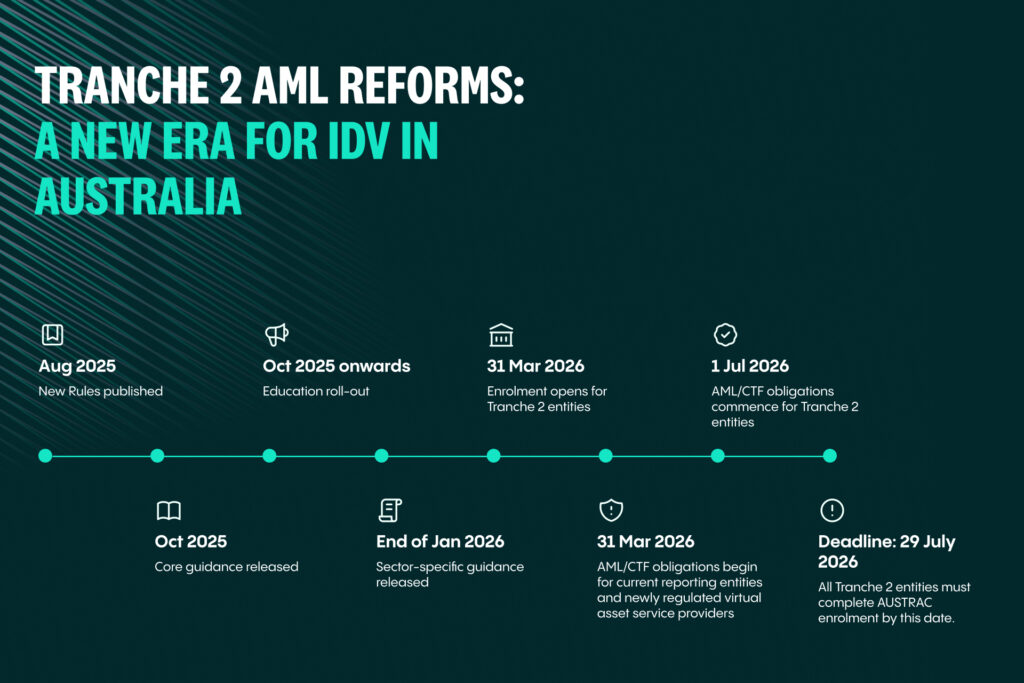IDV Article
Tranche 2 AML reforms: A new era for IDV in Australia
Australia’s AML/CTF reforms are expanding beyond the financial sector for the first time in over a decade, bringing law firms, accountants, and real estate agents into scope. With new compliance duties coming 1 July 2026, understanding the rules—and modern digital ID verification—is essential.

Australia’s anti-money laundering and counter-terrorism financing (AML/CTF) framework is undergoing its most significant expansion in over a decade. The proposed Tranche 2 reforms will extend compliance obligations beyond the financial sector to a new group of professions. For many law firms, accountants, and real estate agents, this marks a fundamental shift in how they manage client relationships and risk.
This article will explore what the Tranche 2 reforms mean for identity verification (IDV) in Australia. We’ll cover which professions are now in scope, their new compliance duties, and why traditional verification methods may fall short. We will also highlight how modern digital IDV solutions can help businesses navigate this new regulatory landscape with confidence.
Who is included in the Tranche 2 reforms?
The Tranche 2 reforms, set to take effect from 1 July 2026, mark a significant expansion of Australia’s anti-money laundering and counter-terrorism financing regime. Under these changes, designated non-financial businesses and professions (DNFBPs) will be subject to AML/CTF regulation for the first time, bringing new compliance responsibilities and a heightened focus on risk management.
Key milestones:
- 2025: Guidance from AUSTRAC, support resources, and education campaigns for newly regulated sectors.
- Up to 1 July 2026: Industry preparation and transition period, including opportunities to consult and clarify obligations.
- From 1 July 2026: Formal commencement of regulation for Tranche 2 entities.

Who will be regulated under Tranche 2?
If your business operates in one of the following sectors, the reforms will directly impact you:
- Law firms & legal professionals: Lawyers, notaries, and legal entities involved in managing client funds, trusts, property, or business transactions.
- Accounting & audit firms: Accountants and auditors, given their access to financial flows and structures, are now required to mitigate risks associated with financial crime.
- Real estate agencies: With property transactions being high-value and attractive for illicit activity, real estate professionals—including agents and developers—are captured by the new rules.
- Trust & Company service providers: Those helping to establish, manage, or administer trusts and companies must now comply with robust AML/CTF programs.
Preparing for the changes:
AUSTRAC recommends all newly regulated entities begin preparation as soon as possible. Start by checking whether your activities fall within the new scope, reviewing AUSTRAC’s guidance, and seeking industry association support. There will be regular updates, targeted education resources, and opportunities to provide feedback as the commencement date approaches.
For virtual asset service providers, specific obligations include conducting customer due diligence, adhering to the travel rule for virtual asset transfers, and ensuring compliance with AML/CTF requirements by March 31, 2026. Transitional rules may extend this deadline, so staying informed is crucial.
Understanding your new compliance obligations
With the Tranche 2 reforms set to take effect from 1 July 2026, AUSTRAC advises all newly regulated entities to start preparing now. Begin by reviewing whether your business activities fall within scope by checking AUSTRAC’s latest guidance, and reach out to your industry association or AUSTRAC directly for clarification if needed. Regular updates, educational resources, and further guidance will be provided as the start date approaches.
Summary of obligations
As a newly regulated business, your core compliance duties will include:
- Identifying and verifying clients: Collecting key information—such as names, addresses, and dates of birth—and verifying this through reliable, independent documents or data sources.
- Understanding beneficial ownership: Determining who ultimately owns or controls company and trust structures involved in your client transactions.
- Monitoring business relationships: Keeping client information up to date and monitoring all activity for unusual or suspicious patterns that might indicate money laundering or terrorism financing risks.
- Suspicious matter reporting: If a client or transaction raises red flags, you must promptly report your suspicions to AUSTRAC according to established internal processes.
- Record keeping: Maintaining accurate records of all due diligence and monitoring activities to demonstrate compliance.
- Ongoing education and updates: Staying informed on guidance and upcoming changes through AUSTRAC’s resources and subscribing to their updates for your sector.
Understanding these requirements is key to building an effective compliance program and minimizing business disruption as the reforms take effect.
Why ‘Bank-Level’ KYC isn’t a perfect fit
While it may seem logical to simply adopt the IDV systems used by banks, these legacy solutions are not always suitable for the professions captured under Tranche 2. Law firms, accountants, and real estate agencies operate with different business models, client expectations, and risk environments.
- Friction and client experience: Traditional KYC processes can be slow and cumbersome, often requiring clients to visit a branch in person or mail certified documents. For professional services firms that pride themselves on high-touch, efficient service, this level of friction can damage the client relationship before it even begins.
- Scalability and cost: Bank-level systems are often built on complex, expensive infrastructure designed for high-volume financial institutions. For a small law practice or boutique accounting firm, the cost and complexity of implementing and maintaining such a system can be prohibitive.
- Operational disruption: Forcing professional staff to follow rigid, manual verification processes distracts them from their core fee-earning work. The ideal solution should integrate smoothly into existing workflows rather than disrupting them.
The role of digital Identity Verification
Modern digital identity verification providers offer a powerful solution to these challenges. By leveraging technology like AI-powered biometrics and automated document analysis, these platforms help businesses meet their Tranche 2 obligations efficiently and securely.
A digital IDV partner can help you:
- Streamline onboarding: Turn a multi-day verification process into a matter of minutes. Clients can verify their identity from anywhere using a smartphone, simply by taking a photo of their government-issued ID and a selfie.
- Enhance security and accuracy: Advanced algorithms can detect fraudulent documents and prevent impersonation with a high degree of accuracy, providing a greater level of assurance than manual checks.
- Reduce the compliance burden: Digital IDV platforms automate the collection, verification, and record-keeping processes, freeing up your team to focus on clients. Audit-ready reports make it easy to demonstrate compliance to regulators.
- Improve accessibility: Serve clients remotely without compromising on security. Digital verification builds trust and allows you to engage with clients across the country or around the world seamlessly.
Seizing the opportunity for innovation
While Tranche 2 introduces new compliance hurdles, it also presents a significant opportunity for forward-thinking firms to innovate and gain a competitive edge. By embracing digital identity verification, you can transform a regulatory requirement into a strategic advantage.
Imagine a client experience where onboarding is fast, secure, and entirely remote. You can establish trust and begin delivering value from the very first interaction. This level of efficiency not only improves client satisfaction but also strengthens your firm’s reputation as a modern, tech-savvy leader in your field. Rather than viewing Tranche 2 as just a cost of doing business, you can use it as a catalyst to build more resilient, efficient, and client-centric operations for the future.
Get ready for Tranche 2
The expansion of Australia’s AML/CTF regime is coming. Now is the time for legal, accounting, and real estate professionals to prepare. By understanding your obligations and exploring modern digital IDV solutions, you can ensure your firm is ready to meet the new standards while enhancing the way you do business.














